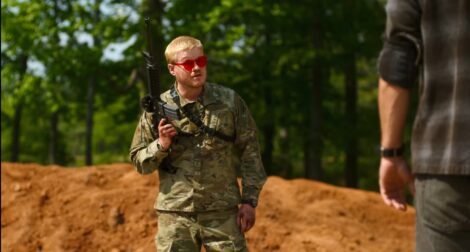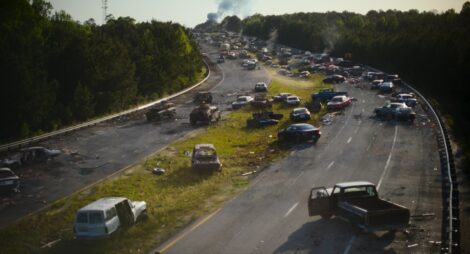Civil War
Front Row at the Movies by Shirrel Rhoades
[mr_rating_result]As Shakespeare said, “What’s past is prologue.” That’s the idea that history sets the context for the present. The quotation is engraved on the National Archives Building in Washington, DC.
The concept is often cited by the military when discussing the similarities between wars throughout history.
 Hollywood is quick to jump on sensational themes. Now playing in theaters is “Civil War,” a dystopian action film that explores what would happen if America faced another civil war.
Hollywood is quick to jump on sensational themes. Now playing in theaters is “Civil War,” a dystopian action film that explores what would happen if America faced another civil war.
The Premise: “In the near future, a team of journalists travel across the United States during the rapidly escalating Second American Civil War that has engulfed the entire nation, between the American government, the separatist Western Forces led by Texas and California, the Florida Alliance, and the New People’s Army. The film documents the journalists struggling to survive during a time when the US government has become a dystopian dictator and partisan extremist militias regularly commit war crimes.”
In this telling, the Western Forces have seceded from the union in response to “an authoritarian third-term President who has jettisoned the Constitution, disbanded the FBI, authorized airstrikes on his own citizens, and now aims to eliminate the final pockets of resistance.”
The film exudes a sense that life as we know it has spiraled out of control.
Kirsten Durst (“Power of the Dog”) stars as a photojournalist named Lee –echoing the famous WWII photojournalist Elizabeth “Lee” Miller. She’s joined by Wagner Moura (TV’s “Narcos”) and Cailee Spaeny (“Priscilla”) as her colleagues Joel and Jessie, and Stephen McKinley Henderson (“Fences”) as their seasoned old mentor, Sammy. The four of them are making their way across the war-torn landscape from New York to Washington DC in their van, hoping to interview the reclusive US President, played by Nick Offerman (TV’s “Parks and Recreation”).
Written and directed by British sc-fi maestro Alex Garland (“Ex Machina,” “Annihilation”), the film is intended to be non-partisan. There is no firm left-vs.-right ideology at play. Having California and Texas (two states that rarely agree on anything) join forces was very intentional.
 Also intentional was not doing a deep dive into the backstory of the conflict. Garland actually mapped out a fictional backstory for the film’s events but deliberately omitted most of it from the screen.
Also intentional was not doing a deep dive into the backstory of the conflict. Garland actually mapped out a fictional backstory for the film’s events but deliberately omitted most of it from the screen.
As one follower observed, “The second you start putting real life politics into it, one side will tune you out. That might be fine for some directors, but Garland has made the decision that the people who probably need to see this the most are the people who would be first turned off by this. The people who are … fetishizing civil conflict have no idea what a modern day civil war in America would look like. Garland wants them to see the effects and change their mind.”
Another adds, “the whole point is that once conflict starts the reasons really don’t matter; the violence and dehumanization becomes the problem regardless of why the conflict was started.”
Online groups have been debating “whether invoking such severe domestic turbulence is irresponsible at a time when the nation’s political divisions have reached a fever pitch.”
“It felt very disturbing,” says Kirsten Durst of the film’s blurring with reality. “Toward the end, it was all the noise and the gunfire, and then just looking at the news and seeing that there’s another school shooting.”
Time Magazine agrees that the movie “felt all too real.”
“It’s an antiwar film, which is problematic to do because cinema doesn’t necessarily want to be antiwar,” Garland says.
I would call it a “cautionary tale.”
As Rolling Stone described the film: “No, it’s not a documentary—yet.”
Email Shirrel: srhoades@aol.com


Ratings & Comments
[mr_rating_form]